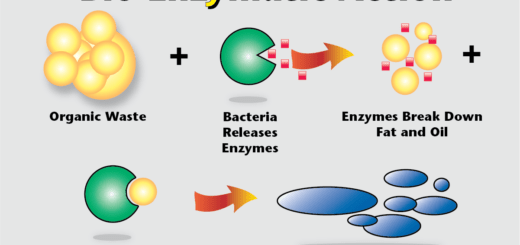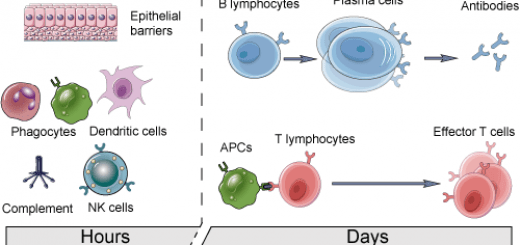DNA, Ribonucleic acids (RNAs), proteins synthesis and types
There is a common plan for the construction of the thousands of kinds of proteins that are found in living systems (living organisms’ bodies), The protein is composed of 20 types of amino acids that have the same basic structure, Amino acids are joined together in dehydration reaction by peptide bonds, forming a polypeptide polymers which form the protein.
Types of proteins
There is an enormous variety of proteins that enter the structure of the body of living organisms and can be divided into two main groups, which are structural proteins and regulatory proteins.
Structural proteins
They are proteins that constitute the building materials in living organisms, such as:
- Actin and myosin: act as the structural elements of muscles and other contractile organs.
- Collagen: forms the connective ligaments within the body.
- Keratin: forms the protective coverings such as skin, hairs, hooves, horns, feathers and others.
Regulatory proteins
They are proteins that regulate the numerous processes and vital activities in the living organism, such as:
- Enzymes: catalyze the chemical reactions in the body of living organisms.
- Antibodies: provide the body with immunity against the infection by foreign bodies.
- Hormones and various other substances: enable the body to respond appropriately to the continuous internal and external environmental changes.
The differences between the different proteins are due to:
- The difference in the numbers, kinds and arrangement of the amino acids in polymers ( polypeptides).
- The number of polymers that form the protein.
- The weak hydrogen bonds that may give the protein molecule its special shape.
Structure of the amino acid
Amino acid is the structural building unit of the protein, The first carbon atom (α-carbon) is attached to the Hydrogen atom (H), Carboxyl group (COOH), Amino group (NH2) & Alkyl group (R) differs from one amino acid to another (found in 19 amino acids), where, Glycine is the only amino acid that has a second hydrogen atom instead of the alkyl group.
Ribonucleic acids (RNAs)
There are many differences and similarities between DNA and RNA, which are:
Both are formed of long unbranched macromolecules that are made up of nucleotide subunits, Each nucleotide is made up of a five-carbon sugar molecule, nitrogenous base and phosphate group, A nucleotide’s phosphate group is bonded to the fifth carbon atom of the sugar molecule of one nucleotide and bonded to the third carbon atom of the sugar molecule of the previous nucleotide to form the sugar-phosphate backbone of the nucleic acid.
DNA
Type of the five-carbon sugar is deoxyribose sugar which contains one less oxygen atom than the ribose, Nitrogenous bases are purines (adenine (A) – guanine (G)), Pyrimidines (thymine (T) – cytosine (C)), The Number of strands are double-stranded molecule (consisting of two complementary chains of nucleotides).
DNA is found inside the nucleus, It transcribes itself, Replication of DNA doesn’t stop until all DNA in the cell is replicated, DNA is stable in the cell (doesn’t hydrolyze) and there is only one type.
RNA
The type of the five-carbon sugar is ribose sugar, Nitrogenous bases are purines (adenine (A) – guanine (G)), Pyrimidines (uracil (U) – cytosine (C)), Number of strands usually consists of a single strand of nucleotides and it may be a double-stranded in some cases.
RNA transfers from the nucleus to the cytoplasm, It is transcribed from DNA, Parts only of DNA are transcribed to build RNA, It is constantly destroyed and rebuilt, three main types contribute in the synthesis of proteins (mRNA, rRNA & tRNA).
Types of ribonucleic acids (RNAs)
The types of ribonucleic acids are messenger RNA (mRNA), Ribosomal RNA (rRNA) and Transfer RNA (tRNA)
Messenger RNA (mRNA)
Transcription of messenger RNA:
- The transcription of DNA into mRNA begins when the RNA-polymerase enzyme binds to a sequence of nucleotides on the DNA called “promoter”.
- The two strands of DNA are separated and one strand serves as a template for the formation of the complementary strand of mRNA in the direction (3‾→ 5‾) and the RNA-polymerase enzyme synthesizes the mRNA in the direction (5‾ → 3‾).
- RNA-polymerase moves along the DNA molecule and joins the complementary ribonucleotides to the growing mRNA strand one by one.
A promoter is a sequence of nucleotides in DNA that directs the RNA-polymerase enzyme to the strand that will be transcribed, then the transcription process begins, At the beginning of mRNA transcription process, the RNA-polymerase recognizes the promoter sequence on the DNA, then it binds to the nucleotides sequence that follows the promoter sequence.
This process is much similar to the replication of DNA, except:
- DNA replication once began, usually copies all the DNA in the cell, while in the case of RNA synthesis, it transcribes only a selected portion of the DNA (that carried the gene).
- Since DNA molecules are double-stranded, theoretically any strand of DNA could be transcribed into different RNA molecules, one complementary to each strand, Practically, only one of the DNA strands is used to transcribe any segment of DNA into RNA, as the orientation of the promoter indicates which strand will be transcribed.
Transcription of mRNA in prokaryotes differs from that of eukaryotes, as follows:
Transcription of mRNA in prokaryotes: A single RNA-polymerase transcribes rRNA, mRNA and tRNA, The mRNA is ready for translation into the corresponding protein as soon as it is transcribed, where the ribosomes bind to the beginning of the mRNA, while the other end is still being synthesized from the DNA template.
Transcription of mRNA in eukaryotes: There are three different kinds of RNA-polymerase, where each type is responsible for transcribing a specific RNA molecule, Translation of mRNA into the corresponding protein doesn’t occur, until the whole mRNA is transcribed in the nucleus, then the mature mRNA transfers to the cytoplasm through the pores of the nuclear membrane for being ready to be translated.
Structure of mRNA molecule
At the beginning of each mRNA molecule: there is a ribosomal binding site which is a sequence of nucleotides that binds to the ribosome, where the first codon (AUG) is positioned correctly upward for translation.
At the end of the mRNA molecule: There is a stop codon which may be one of three codons (UAA, UAG and UGA), There is a polyadenine tail (poly.A) which is composed of about 200 adenosine, It appears that this tail protects the mRNA from the breaking down by the enzymes that found in the cytoplasm.
Adenosine is an adenine base that binds to the ribose sugar, but it is not considered as nucleotide, due to the absence of the phosphate group, so, it doesn’t represent a code.
Ribosomal RNA (rRNA)
The function of rRNA: Four different types of rRNA and about 70 kinds of polypeptides contribute to the synthesis of the ribosomes (organelles of proteins synthesis in the cell).
Production of ribosomes in eukaryotes: The production of ribosomes takes place in an area inside the nucleus called “the nucleolus”, Several hundred thousand of ribosomes are produced per hour in eukaryotic cells, such rapid production is possible only.
Because an eukaryotic cell’s DNA contains up to 600 copies of the ribosomal RNA genes from which rRNA is transcribed, where they contribute to the production of ribosomes that are needed by cells.
A functional ribosome consists of two subunits:
- Large subunit that has 2 sites which are: The first is a peptidyl site (P), The second is the aminoacyl site (A).
- Small subunit: that binds with the mRNA at the beginning of the protein synthesis.
When the ribosome is not engaged in protein synthesis, the two subunits separate and move around independently, Each may join to a different subunit of the opposite type in the next time they will participate in protein synthesis.
The polypeptides of the ribosomes are made in the cytoplasm, then pass through the nuclear envelope and enter the nucleolus, where the rRNA and polypeptides are assembled into the two ribosomal subunits, During protein synthesis, an interaction occurs between the mRNA and rRNA.
Transfer RNA (tRNA)
The function of tRNA: The tRNA participates in protein synthesis, it carries the amino acids to the ribosomes, For each kind of amino acid, there is a specific kind of tRNA molecule that will recognize it, and then transport it.
The amino acids for which there are several different codons have more than one distinct kind of tRNA, So, the number of tRNA molecules is more than 20, The tRNA is transcribed from the tRNA genes on DNA which are often arranged in the clusters of seven or eight tRNA genes in the same part of DNA molecule.
The general structure of tRNA
All tRNA molecules have the same general shape, where parts of the molecule are folded back in characteristic loops that are held in shape (maintain their shape) by base-pairing between the different areas of the molecule.
Two sites on tRNA molecule are important in protein synthesis:
- First: this site consists of the three bases (CCA) at the (3‾) end of the molecule, where the amino acid is attached to the molecule.
- Second: this site is the anticodon site whose bases paired with the appropriate mRNA codon at the mRNA ribosome complex, This temporarily binds the tRNA to the mRNA, allowing the amino acid that is carried by the tRNA to be incorporated into the polypeptide chain in its proper place.
Kinds of mutation according to its inheritance, importance, position and origin of mutation
Packaging of DNA, Genome, chromosomal proteins, DNA in Prokaryotes & Eukaryotes
Genetic code, formation of amino acid code & Steps of Protein synthesis
Importance of Nucleosides, Nucleotides, Purines, Pyrimidines & Sugars of nucleic acids
Regulation of the cell cycle, DNA synthesis phase, Interphase & Mitosis



